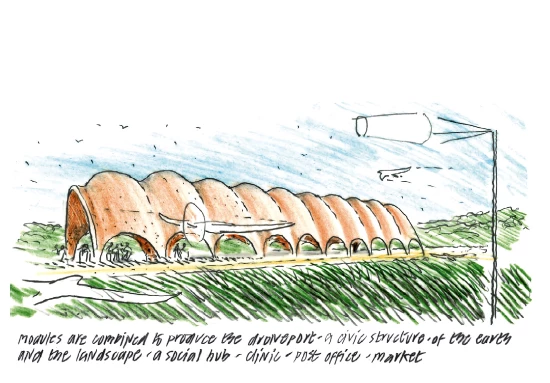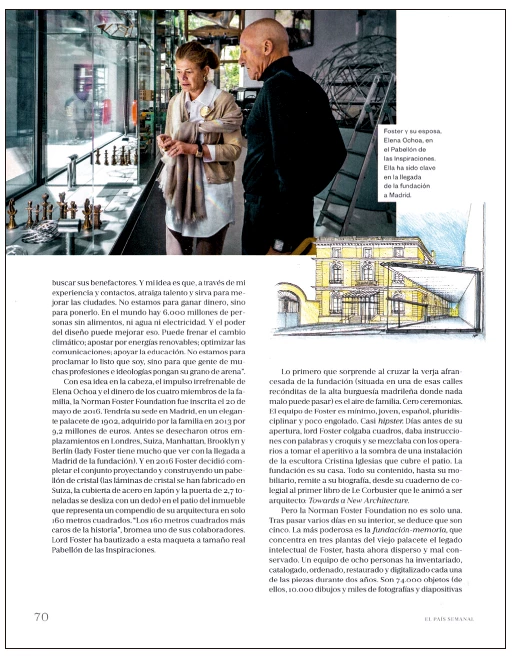Common Futures

From his first works over half a century ago, the architecture of Norman Foster has used technical knowledge to prefigure the future and overcome physical and social barriers. Inspired as much in historical buildings as in scientific developments, his projects reconcile tradition and modernity, urban intelligence and transformative capacity, aesthetic excellence and technological innova-tion. Coinciding with the public launch of his own Foundation in Madrid, which gathered on 1 June at the Royal Theater an extraordi-nary list of figures who were welcomed by the city mayor Manuela Carmena, from Michael Bloomberg or Jonathan Ive to Olafur Eliasson or Christiane Amanpour, the exhibition organized at the Espacio Fundación Tele-fónica in its Gran Vía headquarters presented twelve recent projects of Foster that were placed in dialogue with twelve proposals from several decades before, to underscore the continuity of his concerns and highlight the variety of his interests.

From interventions in heritage buildings to lunar habitation projects, Foster’s work recovers the memory of the past and foresees future needs while remaining firmly grounded in the demands and urges of the present. Be it new spaces for work or culture, attention to cancer patients or populations lacking in infrastructures, sustainable urban developments, or elevated bicycle routes, Foster’s proposals stimulate the effort to make our cities more livable, and all this under the sign of social sensibility, of openness to change, and of innovation.

Si el diario El País publicó un gran reportaje sobre Norman Foster el año de la culminación de Apple, Bloomberg y su propia Fundación, AV le dedicó su número 200 coincidiendo con la exposición en Telefónica.
The future of the past and of culture is il-lustrated by relating his careful extension of the mythical Château Margaux winery to his first drawings of vernacular buildings while still a student, and comparing his current project to extend the Prado Museum to the 17th century Hall of Realms with the Carré d’Art completed twenty-five years ago in Nîmes. For their part, the futures of form and architectural function connect the recently completed headquarters for Bloomberg in the City of London with the one he built for Willis Faber & Dumas more than forty years ago, and the new Casa de Gobierno in Buenos Aires with the innovative Sainsbury Centre, which transformed the perception of spaces for art in its day.
The future of work and the future of wellness bring together the emblematic head-quarters in California’s Bay Area for Apple, recently inaugurated in Cupertino, with the pioneering project for the Norwegian ship-owner Fred Olsen on London’s docks, and the welcoming Maggie’s Centre for people affected by cancer with the Hackney school for children with special needs. In Foster’s work the will to address contemporary needs merges with technical refinement, and both the future of building and that of technology are explored here linking the titanic project for Mexico Airport with the Climatroffice – the never built visionary proposal designed with Buckminster Fuller –, and the sustainable Droneport with the geodesic elementality of their Autonomous House.

Both city and territory urge rethinking the future of mobility and of sustainability, a task shown here by relating the inspiring SkyCycle urban project with the popular Bilbao Metro, and the ‘carbon neutral’ Masdar City with the visionary ecological masterplan for Gomera Island. Finally, the future of networks that thread the planet and even of the expansion of humanity beyond its limits suggests presenting together the colossal Thames Hub scheme and Barcelona’s Collserola Tower, and the lunar base for the European Space Agency, built with robots and 3D technology, with the architect’s first work, a small shelter shaped like the cockpit of a plane.
If the first project of the Norman Foster Foundation, housed in a beauxartian palace to which the architect has added an exquisite glass pavilion, was the Droneport presented at the Venice Architecture Biennale – a small airport for drones that hopes to contribute to development in Africa –, it is only appropriate that its first exhibition took place under the auspices of Fundación Telefónica, in a building completed in 1929 that was a model for innovation in its day, and whose formidable structure was brought out through the exhibition design. And it is also appropriate that the central space of the exhibition should be occupied by machines at the service of movement – from the bicycle to the space capsule – which are at once inspiration for these light architectures and symbols of an accelerated world in constant flux





